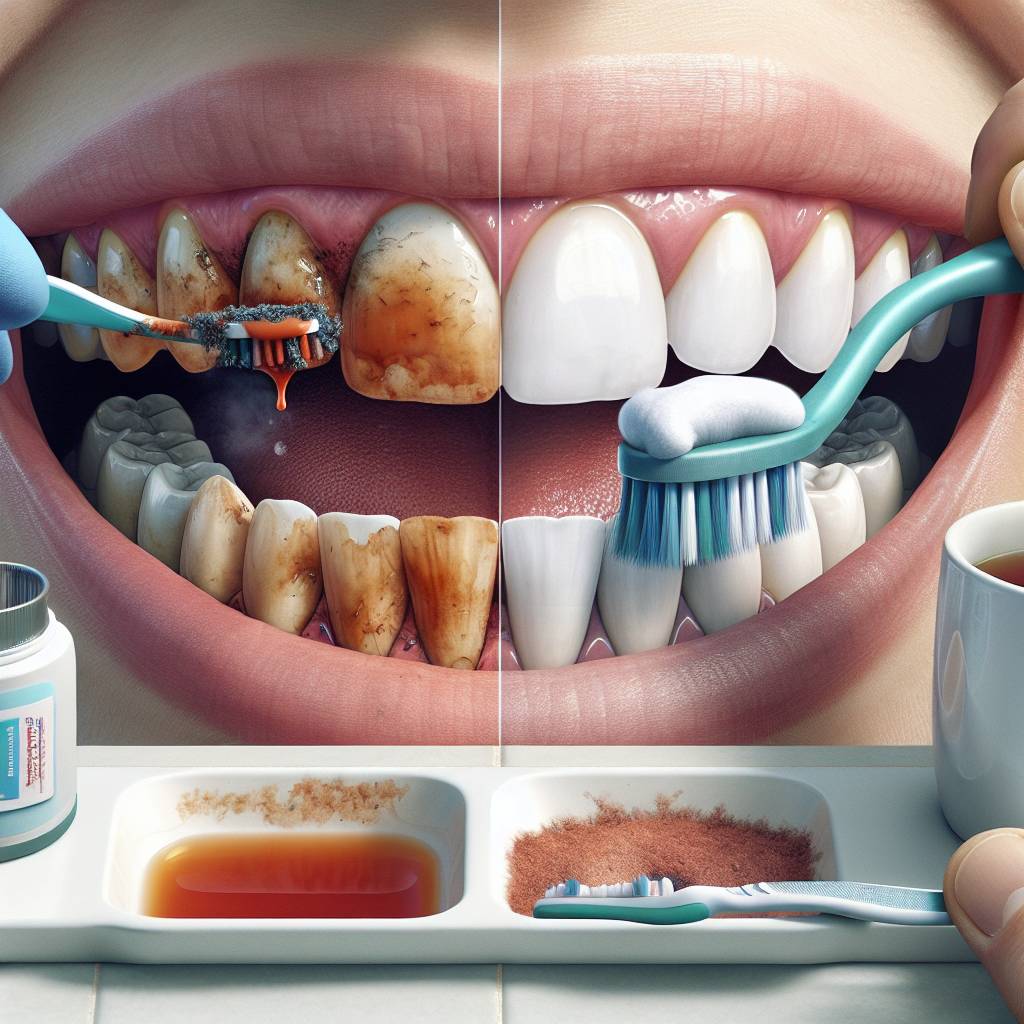If you’ve ever had a cup of tea and noticed a brown or yellow stain on your teeth afterward, you’re probably wondering how to get rid of it. Tea stains on teeth can be unsightly and embarrassing, but the good news is that they can be removed with a few simple steps. In this article, we will discuss how to get tea stains off your teeth and provide some tips for preventing them in the future.The best way to remove tea stains from teeth is to brush them with a soft-bristled toothbrush and fluoride toothpaste. Flossing and using a mouthwash can also help to remove the stains. If the stains are particularly persistent, it may be necessary to visit a dentist who can provide professional cleaning services.
How to Clean Teeth After Drinking Tea
Drinking tea can be a part of a healthy lifestyle, but it can also cause damage to your teeth if you don’t take care of them properly. Tea contains tannins, which are natural compounds that can stain teeth and erode enamel. To keep your teeth healthy and white, it’s important to clean your teeth after drinking tea. Here are some tips for how to clean your teeth after drinking tea:
Brush Your Teeth: Brushing your teeth twice a day is the best way to keep your mouth clean and free of plaque. After drinking tea, make sure to brush thoroughly with a fluoride toothpaste. This will help remove any tannins that may have stuck to the surface of the enamel and prevent staining.
Floss Regularly: Flossing regularly helps remove food particles and plaque from between the teeth, which can help prevent staining from tannins in tea. Make sure to floss at least once a day, preferably after each meal or snack.
Use Mouthwash: Using an antibacterial mouthwash is another way of keeping your mouth clean and free of plaque-causing bacteria. Make sure to swish with mouthwash for at least 30 seconds before spitting it out in order to get rid of any remaining tannins in the mouth.
Chew Sugarless Gum: Chewing sugarless gum can help increase saliva production in the mouth, which helps wash away food particles and bacteria that could cause staining from tannins in tea. Chew sugarless gum for at least 20 minutes after drinking tea for best results.
Drink Water: Drinking plenty of water is important for overall oral health and hygiene. Drinking water after drinking tea helps rinse away any lingering tannins on the surface of the teeth and reduce their chance of becoming stained or eroded over time.
Natural Remedies for Removing Tea Stains From Teeth
Tea is one of the most widely consumed beverages in the world. While it’s certainly delicious, it can also stain your teeth if you’re not careful. Fortunately, there are some natural remedies you can use to help remove tea stains from your teeth.
One of the most effective remedies is to mix baking soda and water and apply it to your teeth with a toothbrush. Baking soda is a mild abrasive that can help to scrub away tea stains. You should brush gently for about two minutes and then rinse your mouth out with water.
Another option is to swish some hydrogen peroxide around in your mouth for up to 30 seconds. This will help to break up any staining particles that may be stuck on your teeth. Make sure you don’t swallow any of the peroxide, as this could be harmful if ingested in large amounts.
You can also try using an apple cider vinegar rinse after brushing with regular toothpaste. Swish around a tablespoon of apple cider vinegar and water in your mouth for 30 seconds and then spit it out. This will help to break up any staining particles that may be stuck on your teeth.
Finally, you can use a mixture of lemon juice and baking soda as a toothpaste substitute and brush twice daily for two minutes each time. The citrus acids in lemon juice work well against tea stains, while the baking soda acts as an abrasive to remove them from your teeth. When you’re done brushing, make sure to rinse out your mouth with water thoroughly so that the lemon juice does not remain in contact with your teeth for too long.
These natural remedies are all effective ways of removing tea stains from your teeth without having to resort to harsh chemical treatments or professional whitening services. Be sure to use them regularly so that you can keep those pearly whites looking their best!
Home Remedies to Get Rid of Tea Stains
It’s inevitable that tea stains can accumulate on your mugs, teacups, and saucers. Tea stains are quite difficult to remove. But fear not! There are a few simple home remedies that will help you get rid of them.
The first home remedy you can try is to use baking soda and water to make a paste. Apply this paste to the stain and scrub gently with a soft cloth or sponge. Rinse with warm water afterwards.
You can also make a vinegar solution by mixing equal parts white vinegar and warm water in a bowl. Soak the stained area in this solution for 30 minutes before rinsing with warm water.
Another option is to rub lemon juice or lime juice on the stain and let it sit for 10-15 minutes before rinsing off with warm water. Lemon juice or lime juice are both acidic so they will help break down the tea stain molecules more quickly.
If you have stubborn tea stains, you can mix salt and lemon juice together to form a thick paste which can be applied directly onto the stained area and scrubbed gently with a soft cloth or sponge before rinsing off with warm water.
Lastly, you can apply toothpaste onto the stained area and scrub gently with a toothbrush before rinsing off with warm water to remove any remaining residue from the stain. Toothpaste is great at removing tough stains as it contains mild abrasives which helps break down the stain molecules more quickly.
These home remedies are effective at removing tea stains from mugs, teacups, and saucers so give them a try!
Does Toothpaste Help Remove Tea Stains From Teeth?
Toothpaste is often used as a cleaning agent to help remove tea stains from teeth, but does it really work? Although toothpaste may help to remove some of the surface stain, it is not designed to remove deep stains that have been on the teeth for a long time. The abrasive ingredients in toothpaste can help to scrub away surface stains, but they are not effective for removing tea stains that are deeply embedded in the enamel.
To get rid of deeper tea stains, you may need to use a professional cleaning procedure such as teeth whitening or bleaching. These processes use powerful bleaching agents or lasers to break down and remove deep-seated tea stains from the enamel. Professional teeth whitening procedures performed at the dentist’s office can be more effective than over-the-counter products because they are tailored to your individual needs and can reach deeper layers of the enamel.
In addition to professional teeth whitening treatments, there are also some natural remedies that may help reduce discoloration and yellowing caused by tea staining. Baking soda and hydrogen peroxide are two popular home remedies that may be able to help lighten tea stains on the teeth. Both baking soda and hydrogen peroxide have mild abrasive properties which can help scrub away surface staining, however these natural home remedies are not as effective as professional whitening treatments.
Overall, toothpaste can help reduce surface staining from tea but it is not designed to remove deep set staining that has been present on the teeth for a long time. In order to effectively get rid of deeper discoloration, you will need professional whitening treatments or natural home remedies such as baking soda or hydrogen peroxide.

How to Avoid Getting Tea Stains on Your Teeth
Regularly drinking tea can cause staining of your teeth over time. While some people embrace the yellow-brown discoloration, others may want to keep their teeth white. Fortunately, there are ways to reduce and prevent tea stains on your teeth.
One of the best ways to avoid tea stains is to drink your tea through a straw. This helps minimize contact with your teeth, so the liquid has less time to set in and cause discoloration. You can also rinse your mouth out with water after drinking tea. This will help remove any residue that can build up and cause staining.
If you don’t have access to a straw or water, try sipping slowly or moving the liquid around in your mouth so it doesn’t stay in one place for too long. Swishing it around will help reduce contact with your teeth. Additionally, you can wait about 30 minutes after eating or drinking before brushing your teeth as this gives the acids time to neutralize and prevents further damage from brushing immediately after consuming acidic foods or drinks like tea.
In addition to these strategies, you can also switch up the type of tea you drink and try lighter varieties that are less likely to stain. Teas such as green, oolong, chamomile and white have lower levels of tannin than darker teas like black tea and Pu-erh which are more likely to cause staining. Avoiding adding milk or sugar also helps decrease the chances of staining as they both contain compounds that create a film on your teeth which traps pigments from the tea and causes discoloration over time.
Are There Any Professional Treatments for Removing Tea Stains from Teeth?
Yes, there are professional treatments available for removing tea stains from teeth. In-office bleaching and whitening kits are two of the most popular treatments for removing tea stains. In-office bleaching is a procedure that involves the application of a special solution to the teeth, which is then exposed to a bright light or laser to activate the bleaching agents in the solution. This process can be completed in one or two office visits and can provide dramatic whitening results.
Whitening kits, also known as take-home whitening kits, are another popular option for removing tea stains. These kits usually consist of custom-fitted trays that contain a bleaching gel, which is applied directly to the teeth overnight for several days in a row. The results may not be as dramatic as those achieved with in-office bleaching, but they can still offer significant whitening benefits.
Overall, professional treatments such as in-office bleaching and take-home whitening kits can be effective at removing tea stains from teeth. It is important to consult with your dentist before undergoing any type of professional treatment for discoloration, as they will be able to provide guidance on the best option for your specific needs and goals.
What Are the Effects of Tea on Teeth?
Tea has been a popular beverage for centuries, and it may have both beneficial and detrimental effects on oral health. While certain compounds in tea can help reduce plaque and bacteria in the mouth, it can also cause staining of the teeth. Therefore, it is important to understand the effects of tea on teeth before consuming it regularly.
The most beneficial compound in tea is fluoride, which helps to strengthen tooth enamel and reduce the risk of cavities. Studies have shown that drinking tea can increase fluoride levels in saliva, providing an additional source of protection for teeth. Additionally, polyphenols in tea have antibacterial properties that can help inhibit growth of bacteria that cause dental decay.
On the other hand, tannins found in tea are responsible for its characteristic flavor and color. Unfortunately, this same compound also has a staining effect on teeth, leading to discoloration over time. To reduce this effect, rinse your mouth with water after drinking tea or use a straw to minimize contact with teeth. Additionally, you should not brush your teeth immediately after drinking tea as tannins can make enamel more susceptible to abrasive damage from brushing.
Overall, drinking tea can be beneficial for oral health if consumed in moderation and combined with other good dental hygiene habits such as brushing and flossing regularly. However, excessive consumption or improper care may lead to staining of the teeth over time so it is important to be aware of these effects when drinking tea.

Conclusion
Tea stains on your teeth can be embarrassing and hard to get rid of. Fortunately, there are a variety of methods that can help you remove tea stains from your teeth. These include brushing your teeth with baking soda and water, using hydrogen peroxide, and using a straw when drinking tea. You can also try using whitening toothpaste or whitening strips to help remove the discoloration.
Overall, it’s important to remember that prevention is the best way to keep your teeth looking healthy and stain-free. Make sure to brush your teeth after each cup of tea and try to limit the amount of tea you drink. Also, if possible, use a straw when drinking tea in order to help protect your teeth from further staining. With these tips in mind, you’ll be able to keep your teeth looking their best!

